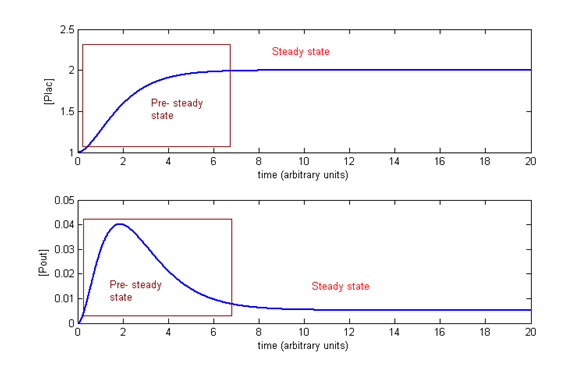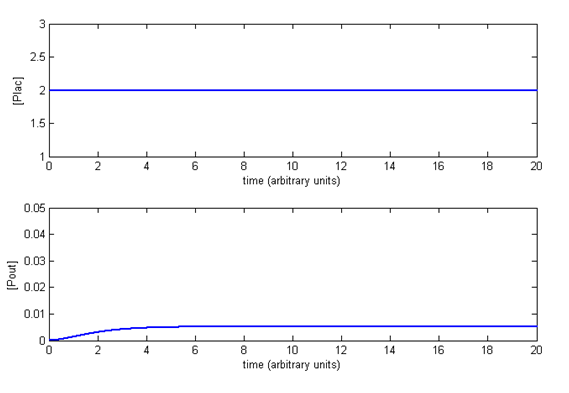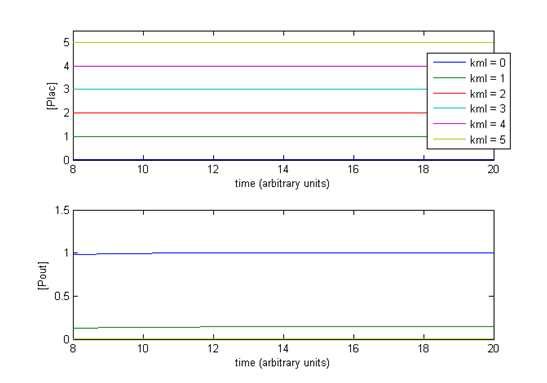Team:Imperial College London/Drylab/Protein production/Simulations
From 2009.igem.org
| Line 3: | Line 3: | ||
<font face='Calibri' size='4'><b>Simulation 1: The state of system prior steady state</b></font><br><br> | <font face='Calibri' size='4'><b>Simulation 1: The state of system prior steady state</b></font><br><br> | ||
| - | We can see that between time units 0 and 7 in the top and bottom plot (where [PlacI] = output amount of LacI and [Pout] = output amount of protein) there is a period of transition towards a fixed | + | We can see that between time units 0 and 7 in the top and bottom plot (where [PlacI] = output amount of LacI and [Pout] = output amount of protein) there is a period of transition towards a fixed concentration. Initially, levels of [PlacI] rise until they reach a constant level, while levels of [Pout] experience a “bump” prior steady state, which settles at a value close to zero when [PlacI] = 2.<br> |
[[Image:II09_PROTM1_SIM1.jpg]]<br> | [[Image:II09_PROTM1_SIM1.jpg]]<br> | ||
| - | + | Expression of LacI repressor protein is constitutive, therefore, the switching on has already taken place prior IPTG induction. Therefore, we assumed that prior IPTG induction, levels of [PlacI], and consequently, [Pout] were originally at their values of steady state, as shown below:<br> | |
[[Image:II09_PROTM1_SIM2.jpg]]<br> | [[Image:II09_PROTM1_SIM2.jpg]]<br> | ||
| - | <font face='Calibri' size='4'><b>Simulation 2: How | + | <font face='Calibri' size='4'><b>Simulation 2: How does the amount of LacI protein affect the amount of protein of interest [Pout] produced?</b></font><br><br> |
Strength of the Lac promoter is associated with the PoPs output (kml). In these simulations we are showing that by varying the strength of the Lac promoter for different arbitrary PoPs values (from 0-5), we can regulate the initial basal expression of protein of interest [Pout]. From the simulations, when levels of Plac are originally low (for a low PoPs output, kml = 0 or 1), we get a high basal expression of [Pout]. This changes when the strength of the promoter is increased (kml=3,4,5), as now levels of [Pout] initially are zero, and virtually repressed. So initial repression of production of protein of interest is effective when the strength of the PLacI promoter is high.<br> | Strength of the Lac promoter is associated with the PoPs output (kml). In these simulations we are showing that by varying the strength of the Lac promoter for different arbitrary PoPs values (from 0-5), we can regulate the initial basal expression of protein of interest [Pout]. From the simulations, when levels of Plac are originally low (for a low PoPs output, kml = 0 or 1), we get a high basal expression of [Pout]. This changes when the strength of the promoter is increased (kml=3,4,5), as now levels of [Pout] initially are zero, and virtually repressed. So initial repression of production of protein of interest is effective when the strength of the PLacI promoter is high.<br> | ||
[[Image:II09_PROTM1_SIM3.jpg]]<br> | [[Image:II09_PROTM1_SIM3.jpg]]<br> | ||
Revision as of 22:53, 13 October 2009

Simulation 1: The state of system prior steady state
We can see that between time units 0 and 7 in the top and bottom plot (where [PlacI] = output amount of LacI and [Pout] = output amount of protein) there is a period of transition towards a fixed concentration. Initially, levels of [PlacI] rise until they reach a constant level, while levels of [Pout] experience a “bump” prior steady state, which settles at a value close to zero when [PlacI] = 2.

Expression of LacI repressor protein is constitutive, therefore, the switching on has already taken place prior IPTG induction. Therefore, we assumed that prior IPTG induction, levels of [PlacI], and consequently, [Pout] were originally at their values of steady state, as shown below:

Simulation 2: How does the amount of LacI protein affect the amount of protein of interest [Pout] produced?
Strength of the Lac promoter is associated with the PoPs output (kml). In these simulations we are showing that by varying the strength of the Lac promoter for different arbitrary PoPs values (from 0-5), we can regulate the initial basal expression of protein of interest [Pout]. From the simulations, when levels of Plac are originally low (for a low PoPs output, kml = 0 or 1), we get a high basal expression of [Pout]. This changes when the strength of the promoter is increased (kml=3,4,5), as now levels of [Pout] initially are zero, and virtually repressed. So initial repression of production of protein of interest is effective when the strength of the PLacI promoter is high.

Simulation 3: How does promoter leakiness affect the basal amount of protein of interest [Pout] produced?
From Equation 4, we remind ourselves that [Pout] at steady state is given by:

Therefore, increasing the leakiness factor k leak (from 0-50%) will increase the basal amounts of [Pout] expressed prior IPTG induction, as can be seen from the figure below.

Simulation 4: How does the introduction of IPTG into the system affect the amount of protein interest [Pout] produced?
Here, we are interested in varying the initial amount of IPTG introduced into the system. We have used arbitrary concentrations of IPTG, going from 0 to 8.

The more IPTG we introduce, the more it temporarily binds to PlacI, thus, reducing its concentration temporarily. While this happens, we either get a smaller or a larger bump in production of protein Pout. Data from the lab will tell us how high the bump will be and how long it will last for.
It may be the case that our assumptions do not apply to this system. Remember that we have only taken into account the constitutive expression of the LacI repressor, and other features of the dynamics of the Lac operon have been neglected. Therefore, our simulations may not match the observed experimental behavior from the lab. However, they are useful in providing us a better understanding of the mechanism involved in protein production.
 "
"



